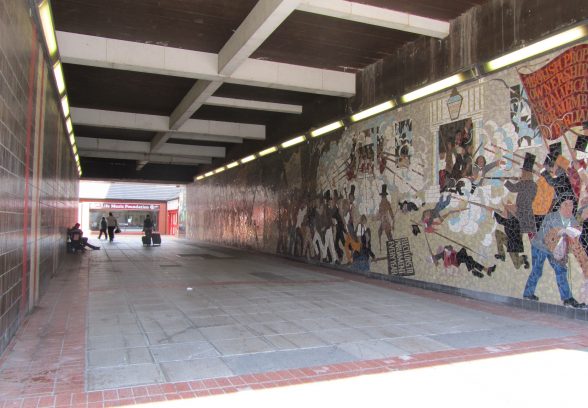This website uses cookies
This website uses cookies to enable it to function properly and to analyse how the website is used. Please click 'Close' to accept and continue using the website.




The Twentieth Century Society is deeply disappointed by CADW’s decision not to list the Chartist Mural in Newport town centre.
The 35m long mural which depicts the Chartist Revolt in life size mosaic figures is one of the best works of post war public art in Wales.
We put it forward for listing due to the threat of demolition as part of redevelopment plans for a new shopping mall in the town centre.
Catherine Croft, Director, Twentieth Century Society said “This is an outstanding example of post war public art in Wales, and it is extremely disappointing that this superb mural will be thrown in the bin to make way for the new shopping centre. We think the mural should be listed to give all sides more time to consider the best way to preserve it.”
“The most sensible solution would have been to retain the mural as part of the new development. This is a work of public art that is hugely important to Newport – it’s a great shame that it wasn’t integrated into the initial redevelopment scheme.
Now that CADW has not been able to acknowledge its historic and artistic significance by listing it, it’s the people of Newport and Wales who will miss out when this work of public art is lost forever”.
We are surprised that CADW has placed so much emphasis on the building to which it is fixed and its context – which they cited as their main reason for not listing the work.
We have been involved in several cases in England where murals have been listed independently from their host building, and either retained in-situ or successfully re-located. CADW also acknowledge in their assessment of the Chartist Mural that Welsh Government legal advice has previously confirmed that works of art affixed to structures can be listed independently.
Yet in their reasons not to list the mural, CADW said, “We fully recognise the significance of the mural as a major piece of public art providing an important connection to the city’s heritage, but in considering the issue of listing, we have to take into account not only the aesthetic qualities of the mural, and the historical associations of its content, but also the aesthetic qualities of the mural and the historical associations of buildings to which the mosaic is attached and the adjacent urban environment…and the integration of the mosaic and its setting. We have concluded that this relationship is not strong enough to warrant listing at the national level”.
The mural depicts the famous 1839 Chartist uprising in the city and is made from 200,000 pieces of ceramic tile and Venetian glass mosaic. The mosaic is so intricately designed that you can see subtle variations in colour, even different skin tones and expressions in the faces of the protesters in the mural. The surface of the mural is not flat – projecting elements like the spears and guns provide an added layer of detail that gives the mural 3-D qualities.
More than 2,000 people have signed an online petition by local campaign group “Save our Chartist Mural” (change.org) to keep the mural which lines a covered walkway off John Frost Square.
The mural was constructed in 1979 by Kenneth Budd, a renowned figure in post war mosaics who produced a wide number of important public art commissions across Wales and the West Midlands. Budd started his career with William Mitchell, one of the best known English post war public artist – several of Mitchell’s works from the 1960s have been listed at our instigation.
The location of the Chartist Mural was deliberately chosen to be placed adjacent to John Frost Square to commemorate the events of 4 November 1839 and to act as a memorial to the 20 Chartists who were killed by soldiers outside the nearby Westgate Hotel.
John Frost, later Mayor of Newport, was one of the Chartists who had marched that day from the Monmouthshire valleys in support of their demands for reform of the parliamentary system then in operation. The six demands of the Great Charter were for voting by secret ballot, a vote for everyone aged over 21, annual elections to Parliament, all constituencies to have an equal numbers of voters, abolition of the property qualification for MPs and payment of MPs.
Ends
For more information contact Henrietta Billings, Senior Conservation Adviser, The Twentieth Century Society Henrietta@c20society.org.uk or 020 7250 3857

Become a C20 member today and help save our modern design heritage.